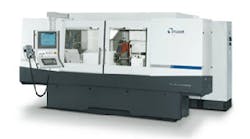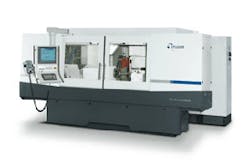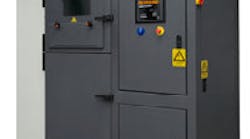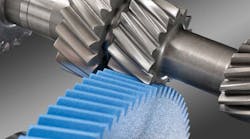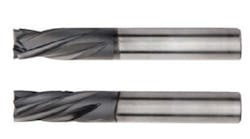United Grinding Technologies’ new Studer S41 CNC universal cylindrical grinder grinds with superior precision and at extreme metal removal rates, the developer reported. It’s designed so that longitudinal and cross slide, as well as the swivel axis for the wheelhead, feature electric direct drives that move to working positions swiftly and precisely.
Higher precision, better surface quality, and higher metal removal rates are constantly increasing requirements, and in addressing these requirements the designers of the United Grinding Technologies’ (UGT) S41 CNC built on proven grinding technologies and added a number of outstanding new features. It works more quickly and precisely, offers a broader range of applications, with several attractive, cost-effective options. By saving on auxiliary times, the S41considerably shortens the cycle times of the grinding process, according to UGT.The Granitan® S103 machine bed is solid, rigid and thermally stable, for optimal grinding operation conditions, and functions as the integrated guide system with a stable basis for absorbing the high forces that occur during grinding, with high metal removal rates.
Rigid machine bed, maintenance-free guide system — Thanks to its thermal behavior, the machine bed largely equalizes brief variations in temperature, so that the machine consistently maintains high precision operation, even with changing ambient temperatures. Its rigidity and damping capability provide the basic prerequisites for outstanding surface quality of ground parts and long grinding wheel lifetimes. The guideways of both the longitudinal slide and the cross slide are molded directly into the machine bed. To ensure that the high forces that occur during grinding with high metal removal rates are optimally absorbed into the machine bed, the guideways have a larger spacing.
The new StuderGuide® guideway system ensures the precision of the longitudinal and cross slides, while stationary and during movement. The StuderGuide system adopts the advantages of hydrostatic and hydrodynamic guide systems and avoids the slip-stick effect or floating of the slide. Also contributing to the machine's high precision is the fact that the cast iron longitudinal and cross slides rest completely on the guideways over the entire travel. With this maintenance-free guide system, UGT guarantees a straightness of <0.0001 in. over a measured length of 37.4 in.
Electric direct drives — The longitudinal slide (Z-axis) has a ground worktable that carries the workhead and tailstock, as well as additional accessories and devices. A ground T-slot over the entire length of the guideway enables optimal positioning of dressing tools. The cross slide (X-axis) supports the wheelhead. Longitudinal and cross slides are moved by linear direct drives and, with up to 66 ft per minute, achieve four times higher travel speeds and axis system resolutions of ten nanometers. This enables high-precision, very efficient grinding, as well as making a huge contribution to reducing auxiliary times.
The swivel movement of the turret wheelhead (B-axis) is also by a direct drive. It swivels the turret wheelhead around three times faster and positions the new grinding wheels in a much shorter time, with a positioning resolution of 0.00005 deg. Therefore, positioning is twice as precise as with the predecessor machine. The elimination of the Hirth gear, which fixed the wheelhead in position on the predecessor machine, also contributes to faster positioning. When swiveling in a new grinding wheel it is no longer necessary to lift the turret wheelhead out of the Hirth gear and then to engage it again by lowering it. The time required for fine adjustment after engaging in the Hirth gear is also saved. This new concept contributes to saving on auxiliary times — particularly when the workpiece grinding process requires frequent swiveling-in of different wheels.
Variants expand users’ market potential — In addition to the considerable increases in working speed and precision, the S41 also has a number of advantageous characteristics that enable the user to cover an extended workpiece range, and thus a broader market range.
For instance, the height of centers on the standard version has been increased to 8.9 in. The machine is also optionally available with a height of centers of 10.8 in.; this is not achieved by means of distance plates, but by making the workheads higher. The maximum distance between centers is 39.4 in. on the standard machine, but a machine variant with a distance between centers of 63 in. is available, too. Thanks to the greater heights of centers and distances between centers, workpieces with weights of up to 551 lb. can now also be machined. The machine is equipped with a hydraulically clamped tailstock for the heavier workpieces.
Up to four external grinding wheels or three internal grinding spindles enable over 30 grinding head combinations. Motor spindles drive the grinding wheels, not belt drives. The machine can be equipped with motor spindles for high-speed grinding (HSG). Internal grinding spindles with speeds from 6,000 to 120,000 rpm can be used. Automatic balancing systems and frequency converters for each external grinding spindle allow the grinding process to be specifically matched to the respective conditions of use. Wheelhead variants also are available with a vertical spindle for grinding keyways or with a traverse-grinding axis for traverse grinding of internal tapers.
Complete manufacturing processes — Fatigue-free working and straightforward machine operation are important components for consistently high quality, so UGT prioritized the S41’s optimized ergonomics. For instance, hoses and cables have largely disappeared from the work area of the machine. Grinding wheels are changed with just one Allen wrench, and a special small crane is integrated into the machine so that heavier grinding wheels do not have to be lifted manually.
The Fanuc 31i-A machine control with integrated PC operates with the StuderGRIND software specially developed for the grinding processes, and the StuderWIN operator interface. A 15-in. touch screen and ergonomically arranged controls are available to the grinder for communication with the control system, and for programming. An additional manual control unit simplifies grinding-process setups.
The software also contains tools for programming form and contour grinding processes, and enables offline programming of grinding processes as well as the determination of important basic cycle data to give the user a good basis to quote grinding tasks to his customers. A freestanding operating panel with adjustable height is available, too.
